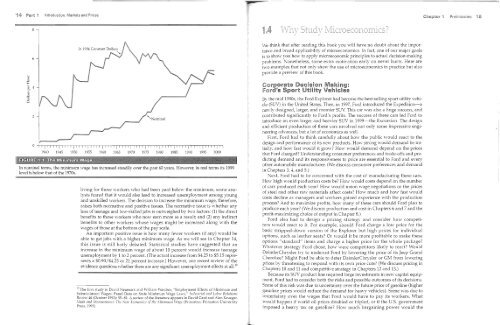Daniel l. Rubinfeld
Daniel l. Rubinfeld
Daniel l. Rubinfeld
Create successful ePaper yourself
Turn your PDF publications into a flip-book with our unique Google optimized e-Paper software.
Introduction: Markets and Prices<br />
Preliminaries<br />
8<br />
6<br />
2<br />
o ~~"-'~"-'''''-'''''-'rT'''-''IT'''''TTI'I'''TTIi'Il' TTliIiTTIi'-TTIi-'IIITTlilili<br />
1940 1945 1950 1955 1960 1965 1970 1975 1980 1985 1990 1995 2000<br />
In nominal terms, the minimum wage has increased steadily over the past 60 years. However, in real terms its 1999<br />
level is below that of the 1970s.<br />
living for those 'i,\'orkers 'who had been paid below the minimum, some analysts<br />
feared that it would also lead to increased unemployment among young<br />
and unskilled workers. The decision to increase the minimum wage, therefore,<br />
raises both normative and positive issues. The normative issue is whether any<br />
loss of teenage and low-skilled jobs is outweighed by two factors: (1) the direct<br />
benefits to those workers 'who nov\' earn more as a result; and (2) any indirect<br />
benefits to other workers whose wages might be increased along with the<br />
"wages of those at the bottom of the pay scale.<br />
An important positive issue is how many fewer workers (if any) would be<br />
able to get jobs with a higher minimum wage. As we 'will see in Chapter 14,<br />
this issue is still hotly debated. Statistical studies have suggested that an<br />
increase in the minimum wage of about 10 percent would increase teenage<br />
unemployment by 1 to 2 percent. (nle actual increase from 54.25 to $5.15 represents<br />
a $0.90/$4.25 or 21 percent increase.) However, one recent review of the<br />
evidence questions whether there are any significant unemployment effects at all. JO<br />
!OIhe first stud\' is Da\"id Neumark and William Wascher, "Employment Effects of Minimum and<br />
Subminimum \~Tages: Panel Data on State Minimum \Vage laws," Industria/and Labor Relations<br />
RCL'icIl,,16 (October 1992): 33-81 A re\'ie\\' of the literahlre appears in Da\'id Card and Alar~ Krueger,<br />
I'vll/th and McasurclIlcllt: Thc Nc,t' Ecollolllics of thc Millilllulll Wagc (Princeton: Pnnceton Ul11\"erslty<br />
Press, 1993)<br />
We think that after reading this book you will have no doubt about the importance<br />
and broad applicability of microeconomics, In fact, one of our major goals<br />
is to show you how to apply microeconomic principles to actual decision-making<br />
problems. Nonetheless, some extra motiv~ti~n early on ~1e\:er hurt:, Here are<br />
two examples that not only show the use ot microeconomiCS 111 prachce but also<br />
provide a previe'w of this book.<br />
Decision Making:<br />
Sport Utility Vehicles<br />
Bv the mid 1990s, the Ford Explorer had become the best-selling sport utility vehicle<br />
(SUV) in the United States, Then, in 1997, Ford inh'oduced the Expedition-a<br />
newly designed, larger, and roomier SUv. This car was also a huge success, and<br />
conh:ibuted sio-nificantly to Ford's profits. The success of these cars led Ford to<br />
introduce an ;;en larg~r and heavier SUV in 1999-the Excursion, The design<br />
and efficient production of these cars involved not only some impressive engineerino-<br />
advances, but a lot of economics as welL<br />
Firs~,<br />
Ford had to think carefully about hoy\' the public would react to the<br />
desio-n and performance of its new products. How strong would demand be inib<br />
h .<br />
tially, and how fast would it grow How would demand depend on t e pnces<br />
that~ Ford charged Understanding consumer preferences and trade-offs and predicting<br />
demand and its responsiveness to price are essential to Ford and every<br />
other automobile manufacturer. (We discuss consumer preferences and demand<br />
in Chapters 3, 4, and 5.)<br />
Next, Ford had to be concerned with the cost of manufacturing these cars.<br />
How high would production costs be How would costs depend on the number<br />
of cars produced each year How would union "wage negotiations or, the prices<br />
of steel and other raw materials affect costs How much and how fast would<br />
costs decline as managers and workers gained experience with the production<br />
process And to maximize profits, how many of these cars should Ford plan to<br />
produce each year (We discuss production and cost in Chapters 6 and 7 and the<br />
profit-maximizing choice of output in Chapter 8.)<br />
Ford also had to design a pricing strategy and consider how competitors<br />
\YOLlld react to it. For example, should Ford charge a low price for the<br />
basic stripped-down \'ersion of the Explorer but high prices for individual<br />
options, such as leather seats Or would it be more profitable to make these<br />
options "standard" items and charge a higher price for the whole package<br />
Whatever strategy Ford chose, how were competitors likely to react Would<br />
DaimlerChrysler try to undercut Ford by lo'wering the price of its Jeep Grand<br />
Cherokee ~1io-ht F~rd be able to deter DaimlerChrysler or GM from lowering<br />
prices by thre:'tening to respond with its own price cuts (We discuss pricing in<br />
Chapters 10 and 11 and competitive strategy in Chapters 12 and 13,)<br />
Because its SUV product line required large investments in new capital equipment,<br />
Ford had to consider both the risks and possible outcomes of its decisions.<br />
Some of this risk was due to uncertainty over the future price of gasoline (higher<br />
o-asoline prices would reduce the dem~nd for heavy vehicles). Some was due to<br />
b ~<br />
uncertainty o\'er the wages that Ford would ha\'e to pay its workers. What<br />
would happen if world oil prices doubled or tripled, or if the U.s. government<br />
imposed a heavy tax on gasoline How much bargaining pO'i,\'er would the

















